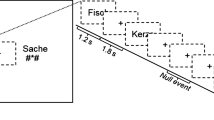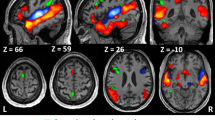Abstract
The Landolt paradigm is a visual scanning task intended to evoke reading-like eye-movements in the absence of orthographic or lexical information, thus allowing the dissociation of (sub-) lexical vs. visual processing. To that end, all letters in real word sentences are exchanged for closed Landolt rings, with 0, 1, or 2 open Landolt rings as targets in each Landolt sentence. A preliminary fMRI block-design study (Hillen et al. in Front Hum Neurosci 7:1–14, 2013) demonstrated that the Landolt paradigm has a special neural signature, recruiting the right IPS and SPL as part of the endogenous attention network. However, in that analysis, the brain responses to target detection could not be separated from those involved in processing Landolt stimuli without targets. The present study presents two fMRI experiments testing the question whether targets or the Landolt stimuli per se, led to the right IPS/SPL activation. Experiment 1 was an event-related re-analysis of the Hillen et al. (Front Hum Neurosci 7:1–14, 2013) data. Experiment 2 was a replication study with a new sample and identical procedures. In both experiments, the right IPS/SPL were recruited in the Landolt condition as compared to orthographic stimuli even in the absence of any target in the stimulus, indicating that the properties of the Landolt task itself trigger this right parietal activation. These findings are discussed against the background of behavioural and neuroimaging studies of healthy reading as well as developmental and acquired dyslexia. Consequently, this neuroimaging evidence might encourage the use of the Landolt paradigm also in the context of examining reading disorders, as it taps into the orientation of visual attention during reading-like scanning of stimuli without interfering sub-lexical information.


Similar content being viewed by others
Notes
Note that, with an average of 78% correct trials (cf. Results), there were around 32 valid trials per condition from which the HRF could be estimated.
References
Ablinger I, von Heyden K, Vorstius C, Halm K, Huber W, Radach R (2014) An eye movement based reading intervention in lexical and segmental readers with acquired dyslexia. Neuropsychol Rehabil 24:833–867
Blau V, Reithler J, van Atteveldt N, Seitz J, Gerretsen P, Goebel R, Blomert L (2010) Deviant processing of letters and speech sounds as proximate cause of reading failure: a functional magnetic resonance imaging study of dyslexic children. Brain 133:868–879
Bosse ML, Tainturier MJ, Valdois S (2007) Developmental dyslexia: the visual attention span deficit hypothesis. Cognition 104:198–230
Bueichekú E, Miró-Padilla A, Palomar-García MA, Ventura-Campos N, Parcet MA, Barrós-Loscertales A, Ávila C (2016) Reduced posterior parietal cortex activation after training on a visual search task. Neuroimage 135:204–213
Connor CM, Radach R, Vorstius C, Day SL, McLean L, Morrison FJ (2015) Individual differences in fifth graders’ reading and language predict their comprehension monitoring development: an eye-movement study. Sci Stud Read 19:114–134
Corbetta M, Shulman GL (2002) Control of goal-directed and stimulus-driven attention in the brain. Nat Rev Neurosci 3:201–215
Corbetta M, Kincade JM, Ollinger JM, McAvoy MP, Shulman GL (2000) Voluntary orienting is dissociated from target detection in human posterior parietal cortex. Nat Neurosci 3:292–297
De Luca M, Di Pace E, Judica A, Spinelli D, Zoccolotti P (1999) Eye movement patterns in linguistic and non-linguistic tasks in developmental surface dyslexia. Neuropsychologia 37:1407–1420
de Fockert J, Rees G, Frith C, Lavie N (2004) Neural correlates of attentional capture in visual search. J Cogn Neurosci 16:751–759
Dehaene S, Pegado F, Braga LW, Ventura P, Nunes Filho G, Jobert A, Dehaene-Lambertz G, Kolinsky R, Morais J, Cohen L (2010) How learning to read changes the cortical networks for vision and language. Science 330:1359–1364
Démonet JF, Taylor MJ, Chaix Y (2004) Developmental dyslexia. Lancet 363:1451–1460
Donner T, Kettermann A, Diesch E, Ostendorf F, Villringer A, Brandt SA (2000) Involvement of the human frontal eye field and multiple parietal areas in covert visual selection during conjunction search. Eur J Neurosci 12:3407–3414
Eickhoff SB et al (2005) A new SPM toolbox for combining probabilistic cytoarchitectonic maps and functional imaging data. NeuroImage 25:1325–1335
Fan J, McCandliss BD, Fossella J, Flombaum JI, Posner MI (2005) The activation of attentional networks. NeuroImage 26:471–479
Ferretti G, Mazzotti S, Brizzolara D (2008) Visual scanning and reading ability in normal and dyslexic children. Behav Neurol 19:87–92
Gabrieli JD (2009) Dyslexia: a new synergy between education and cognitive neuroscience. Science 325:280–283
Gagl B, Hawelka S, Hutzler F (2014) A similar correction mechanism in slow and fluent readers after suboptimal landing positions. Front Hum Neurosci 8:355
Günther T, Radach R, Huestegge L (2012). Blickbewegungen beim Lesen, Leseentwicklung und Legasthenie. Lernen und Lernstörungen 1:185–204
Heim S, Grande M (2012) Fingerprints of developmental dyslexia. Trends Neurosci Educ 1:10–14
Heim S, Tschierse J, Amunts K, Wilms M, Vossel S, Willmes K, Grabowska A, Huber W (2008) Cognitive subtypes of dyslexia. Acta Neurobiol Exp 68:73.82
Heim S, Grande M, Meffert E, Eickhoff SB, Schreiber H, Kukolja J, Shah NJ, Huber W, Amunts K (2010a) Cognitive levels of performance account for hemispheric lateralisation effects in dyslexic and normally reading children. Neuroimage 53:1346–1358
Heim S, Grande M, Pape-Neumann J, van Ermingen M, Meffert E, Grabowska A, Huber W, Amunts K (2010b) Interaction of phonological awareness and “magnocellular” processing during normal and dyslexic reading: behavioural and fMRI investigations. Dyslexia 16:258–282
Helland T, Morken F (2016) Neurocognitive development and predictors of L1 and L2 literacy skills in dyslexia: a longitudinal study of children 5–11 years old. Dyslexia 22:3–26
Hillen R, Günther T, Kohlen C, Eckers C, van Ermingen-Marbach M, Sass K, Scharke W, Vollmar J, Radach R, Heim S (2013) Identifying brain systems for gaze orienting during reading: fMRI Investigation of the Landolt paradigm. Front Hum Neurosci 7:1–14
Hutzler F, Wimmer H (2003) Eye movements of dyslexic children when reading in a regular orthography. Brain Lang 89:235–242
Hutzler F, Kronbichler M, Jacobs AM, Wimmer H (2006) Perhaps correlational but not causal: no effect of dyslexic readers’ magnocellular system on their eye movements during reading. Neuropsychologia 44:637–648
Leppänen PH, Hämäläinen JA, Salminen HK, Eklund KM, Guttorm TK, Lohvansuu K, Puolakanaho A, Lyytinen H (2010) Newborn brain event-related potentials revealing atypical processing of sound frequency and the subsequent association with later literacy skills in children with familial dyslexia. Cortex 46:1362–1376
Lobier MA, Peyrin C, Pichat C, Le Bas JF, Valdois S (2014) Visual processing of multiple elements in the dyslexic brain: evidence for a superior parietal dysfunction. Front Hum Neurosci 8:479
Lukov L, Friedmann N, Shalev L, Khentov-Kraus L, Shalev N, Lorber R, Guggenheim R (2015) Dissociations between developmental dyslexias and attention deficits. Front Psychol 5:1501
Lyytinen H, Erskine J, Hämäläinen J, Torppa M, Ronimus M (2015) Dyslexia-early identification and prevention: highlights from the Jyväskylä longitudinal study of dyslexia. Curr Dev Disord Rep 2:330–338
Madden DJ, Parks EL, Tallman CW, Boylan MA, Hoagey DA, Cocjin SB, Johnson MA, Chou YH, Potter GG, Chen NK, Packard LE, Siciliano RE, Monge ZA, Diaz MT (2017) Frontoparietal activation during visual conjunction search: effects of bottom-up guidance and adult age. Hum Brain Mapp 38:2128–2149
Martin A, Schurz M, Kronbichler M, Richlan F (2015) Reading in the brain of children and adults: a meta-analysis of 40 functional magnetic resonance imaging studies. Hum Brain Mapp 36:1963–1981
Martin A, Kronbichler M, Richlan F (2016) Dyslexic brain activation abnormalities in deep and shallow orthographies: a meta-analysis of 28 functional neuroimaging studies. Hum Brain Mapp 37:2676–2699
Maurer U, Bucher K, Brem S, Benz R, Kranz F, Schulz E, van der Mark S, Steinhausen HC, Brandeis D (2009) Neurophysiology in preschool improves behavioral prediction of reading ability throughout primary school. Biol Psychiat 66:341–348
Nobre AC, Coull JT, Walsh V, Frith CD (2003) Brain activation during visual search: contributions of search efficiency versus feature binding. Neuroimage 18:91–103
Peters K, Scharke W, Willmes K, Radach R, Günther T (2015) Blickbewegungen bei Dyslexie und Aufmerksamkeitsdefizit. Sprache Stimme Gehör 39:S3–S4
Prado C, Dubois M, Valdois S (2007) The eye movements of dyslexic children during reading and visual search: impact of the visual attention span. Vis Res 47:2521–2530
Radach R, Günther T, Huestegge L (2012) Blickbewegungen beim Lesen, Leseentwicklung und Legasthenie. Lernen und Lernstörungen 1(3):185–204
Ramus F (2003) Developmental dyslexia: specific phonological deficit or general sensorimotor dysfunction? Curr Opin Neurobiol 13:212–218
Ramus F (2004) Neurobiology of dyslexia: a reinterpretation of the data. Trends Neurosci 27:720–726
Ramus F, Rosen S, Dakin SC, Day BL, Castellote JM, White S, Frith U (2003) Theories of developmental dyslexia: insights from a multiple case study of dyslexic adults. Brain 126:841–865
Rayner K (1998) Eye movements in reading and information processing: 20 years of research. Psychol Bull 3:372–422
Reid AA, Szczerbinski M, Iskierka-Kasperek E, Hansen P (2007) Cognitive profiles of adult developmental dyslexics: theoretical implications. Dyslexia 13:1–24
Reilhac C, Peyrin C, Démonet JF, Valdois S (2013) Role of the superior parietal lobules in letter-identity processing within strings: FMRI evidence from skilled and dyslexic readers. Neuropsychologia 51:601–612
Richlan F, Kronbichler M, Wimmer H (2011) Meta-analyzing brain dysfunctions in dyslexic children and adults. Neuroimage 56:1735–1742
Richlan F, Gagl B, Hawelka S, Braun M, Schurz M, Kronbichler M, Hutzler F (2014) Fixation-related FMRI analysis in the domain of reading research: using self-paced eye movements as markers for hemodynamic brain responses during visual letter string processing. Cereb Cortex 24:2647–2656
Schaadt G, Männel C, van der Meer E, Pannekamp A, Oberecker R, Friederici AD (2015) Present and past: can writing abilities in school children be associated with their auditory discrimination capacities in infancy? Res Dev Disabil 47:318–333
Stein J (2001) The magnocellular theory of developmental dyslexia. Dyslexia 7:12–36
Thiel CM, Zilles K, Fink GR (2004) Cerebral correlates of alerting, orienting and reorienting of visuospatial attention: an event-related fMRI study. NeuroImage 21:318–328
Valdois S, Bosse MLB, Ans B, Carbonnel S, Zorman M et al (2003) Phonological and visual processing deficits can dissociate in developmental dyslexia: evidence from two case studies. Read Writ 16:1–32
van Ermingen-Marbach M, Grande M, Pape-Neumann J, Sass K, Heim S (2013) Distinct neural signatures of cognitive subtypes of dyslexia: an fMRI study on phonological processing in developmental dyslexics with and without phonological deficits. Neuroimage Clin 2:477–490
van der Leij A, van Bergen E, van Zuijen T, de Jong P, Maurits N, Maassen B (2013) Precursors of developmental dyslexia: an overview of the longitudinal Dutch Dyslexia Programme study. Dyslexia 19:191–213
Wimmer H, Ludersdorfer P, Richlan F, Kronbichler M (2016) Visual experience shapes orthographic representations in the visual word form area. Psychol Sci 27:1240–1248
Yan Y, Wei R, Zhang Q, Jin Z, Li L (2016) Differential roles of the dorsal prefrontal and posterior parietal cortices in visual search: a TMS study. Sci Rep 6:30300
Zhou W, Shu H (2017) A meta-analysis of functional magnetic resonance imaging studies of eye movements and visual word reading. Brain Behav 7:e00683
Acknowledgements
This research was funded by the National German Research Agency (Deutsche Forschungsgemeinschaft) Grant GU-1177/1-1. We wish to thank Ralph Weidner for his insightful comments on an earlier version of this manuscript.
Funding
This research was funded by the National German Research Agency (Deutsche Forschungsgemeinschaft) Grant GU-1177/1-1 to TG and SH.
Author information
Authors and Affiliations
Corresponding author
Ethics declarations
Conflict of interest
The author declares that there is no competing interest.
Research involving human participants
This study was conducted on healthy human volunteers in accordance with the Declaration of Helsinki.
Informed consent
Informed written consent was obtained from all participants.
Ethical approval
Ethical approval was obtained from the Ethics Committee at the Medical Faculty of RWTH Aachen University.
Rights and permissions
About this article
Cite this article
Heim, S., von Tongeln, F., Hillen, R. et al. Reading without words or target detection? A re-analysis and replication fMRI study of the Landolt paradigm. Brain Struct Funct 223, 3447–3461 (2018). https://doi.org/10.1007/s00429-018-1698-x
Received:
Accepted:
Published:
Issue Date:
DOI: https://doi.org/10.1007/s00429-018-1698-x




